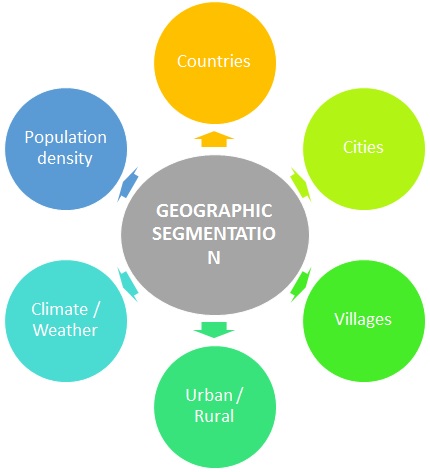- Business Concepts ›
- Marketing and Strategy ›
- Geographic Segmentation
Geographic Segmentation
Definition, Importance, Parameters & Example
This article covers meaning & overview of Geographic Segmentation from marketing perspective.
What is meant by Geographic Segmentation?
Geographic segmentation is a segmentation strategy in which the market is divided into different groups on the basis of regions or geographies. Geographic segmentation can be classified by parameters like countries, states, cities, villages, urban / rural, climatic conditions, density of population. This type of segmentation helps to reach out to customers living in a similar region or area and have identical needs.
Importance of Geographic Segmentation
People living in the same area or region often have similar needs and requirements. Certain products are made specifically for a purpose best suited to needs of the people living in a certain region. Hence, geographic segmentation helps identify those set of customers who are living in a particular region or area or place and also have similar features like weather, climate etc.
Since the time marketing has started, adapting products to local needs has always been top of the list. Geographic segmentation helps in knowing the target audience better.
A single product and services can be adapted to multiple geographies if the segmentation is done correctly. Minor adaptations can go a long way in making a product successful in multiple geographies. Adjustments to marketing mix as per the geography can help the product sell better and provide more value.
Geographic segmentation is one of the four types of market segmentation. The other three are demographic segmentation, behavioral segmentation and psychographic segmentation.
Read More
Geographic Segmentation Parameters
Since this type of segmentation depends upon the region or areas, below are the parameters related to geographic segmentation:
1. Country
Certain companies make products or services which are specific to only a country. This type of geographic segmentation helps target people from a specific country or a set of counties. Even regions like APAC, NA, EMEA etc. can be used for segmentation.
2. City
Cities offer a huge potential market to companies. Hence companies often select specific cities for their products or services. Again like countries group of countries like all the cities of the northern part of a country or all cities speaking common language can be used as a parameter.
3. Villages
Some villages can be identified by companies which give the best set of customers to companies to their business with. A good example can be villages where agriculture is major source of occupation.
4. Urban/ Rural
Certain products or services can be offered only to the urban population and certain products are rural area specific. Products and demands can be very different when it comes to urban and rural markets.
5. Climate and weather
Companies use this type of geographic segmentation and identify customers of a region with similar climatic conditions. Areas based on climate can be hot, cold, humid etc. and based on weather can be snowfall, rainfall, desert etc.
Certain markets have multiple seasons over the year hence the strategies can also change. A company which sells T-shirts in summers can plan for jackets in the winter season.
6. Population density
Depending upon the number of people in an area or region, companies can use density of population as a parameter to effectively segment the market.

The above image shows the various parameters used in geographic segmentation.
Advantages of Geographic Segmentation
The benefits of segmenting the market on the basis of geography, areas and regions are:
1. It helps identify people living in a similar region who mostly have similar needs and wants
2. Geographic segmentation means companies can concentrate their spending in a particular region which can enhance brand visibility significantly
3. Since geographies are well defined through borders, climate, topography etc. it becomes easier for companies to identify them and find out potential customers
4. Densely populated areas can lead to huge market potential for a company to offers its products or services
Disadvantages of Geographic Segmentation
The certain drawbacks of segmenting on the basis of geography are:
1. This does not highlight the buying behavior, needs or wants of a customer. People living in the same region can have different requirements
2. Weather in a region keeps on changing and there have been climatic changes also. Hence simply having geographic segmentation will not be a good solution for a marketing company.
Geographic Segmentation Examples
There can be several way in which this topic can be understood. Certain examples of geographic segmentation are:
1. Country- Sarees are sold in countries like India, flags are sold only in their respective country etc.
2. Cities- Replicas of Eiffel Tower will be sold in Paris, products depicting Taj Mahal will do well in Agra.
3. Villages- Companies doing sugar business can target villages growing sugarcane, tea manufacturing companies can target tea farms.
4. Urban/ Rural- Hand pumps are required in rural areas, stores of premium watch or car brands can be opened in urban areas
5. Climate and weather- Beachwear can be sold in areas close to the sea, sweaters in cold regions, raincoats in areas receiving high rainfall, ice-creams in hot regions
Hence, this concludes the definition of Geographic Segmentation along with its overview.
This article has been researched & authored by the Business Concepts Team which comprises of MBA students, management professionals, and industry experts. It has been reviewed & published by the MBA Skool Team. The content on MBA Skool has been created for educational & academic purpose only.
Browse the definition and meaning of more similar terms. The Management Dictionary covers over 1800 business concepts from 5 categories.
Continue Reading:
What is MBA Skool?About Us
MBA Skool is a Knowledge Resource for Management Students, Aspirants & Professionals.
Business Courses
Quizzes & Skills
Quizzes test your expertise in business and Skill tests evaluate your management traits
Related Content
All Business Sections
Write for Us